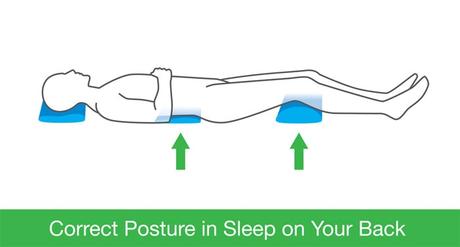Before we explain how to train yourself to sleep on your back, first let's consider the view of a prominent New York doctor. Fifth Avenue dermatologist, Debra Jaliman MD, published her book Skin Rules in 2012. It is fundamentally an instruction book on how to get beautiful skin and look younger than your years.
Part of this book refers to sleeping on your side, where sleeping with your face scrunched on a pillow can lead to fine lines and wrinkles. Dr. Jaliman concludes that it's best to sleep on your back rather than your side, although most people find it difficult to do so. This is one good reason sleeping on your back rather than your side or belly. The trouble is, most people find sleeping on their back unnaturally, possibly because the fetal position is inborn. It is likely, therefore, that you will have to learn how to sleep on your back.

Why Learn How to Sleep on Your Back?
There are three main sleeping positions: back, side and stomach. Sleeping on your back can do more for you than prevent or reduce wrinkling of your face. It offers a number of health benefits such as helping maintain good alignment of your spine. A memory foam mattress is ideal for maintaining the natural elongated S shape of your spine while you sleep. You need specific support at your neck - the top curve of your spine in the cervical region, and at the lower curve of the S or the curvature of your lower spine.
By learning how to sleep on your back, you can achieve this while your face is exposed to the air rather than scrunched or compressed into a rumpled pillow. Reduce wrinkling of the skin of your face and maintaining a good, natural shape to your spine are not the only benefits for back sleepers. If you are a woman, then you can help maintain your breast shape if sleep on your back. If you are subject to bouts of acid reflux when in bed, then sleeping on your back can reduce these.
Why Can't You Properly Sleep on Your Back?
Many people find it difficult to get to sleep lying on their back. Why is this? Why is it that some people find it easy to sleep on their side or stomach, but not on their back? Only around 14% of people sleep on their back. One theory for this is that the fetal position of side sleeping comes naturally. Most people sleep on their side throughout their lives because that is the position they are used to, from soon after conception to birth.
Many people also use the fetal or side sleeping position for napping during the day. Only around 14% - 15% of people sleep on their back, even though it is the most logical position given the human anatomy. According to Dr. Jaliman, if you have learned how to sleep on your back without ending up sleeping on your side in the fetal position, then you will be able to take advantage of the cosmetic and orthopedic advantages of doing so. So what tips does she give to enable you to achieve this way of sleeping?
How to Train Yourself to Sleep on Your Back Properly
Sleeping on your back is fairly simple to do, although it may take you some time to get used to it. Here are some simple instructions on the first steps to take:
- Lie down flat on your back.
- Keep your head straight and not twisted to either side.
- Keep your legs straight and not twisted to either side.
- Fall asleep.
Of course, it is never as simple as that. You can keep your arms straight down, though many prefer to raise them backwards around the area of their head. Use a flattish pillow rather than one that significantly raises your head. You can make it easier to sleep on your back by using a pillow designed to keep you in that position while sleeping.
Most people who begin by sleeping on their back tend to move while sleeping and revert to their preferred side position. Check out InsideBedroom's Best Pillows Ever reviews for our opinion of the best pillows for back sleepers. Alternatively, try our Best Pillows for Neck Pain Reviews. Not all pillows are good for back sleepers, although there are some that are ideal and also help prevent neck pain. Among these are buckwheat pillows, made using buckwheat haulms or hulls and shaped for your head and neck. Dr. Jaliman recommends you to use other pillows along with these to support your head so you are unlikely to turn round when you are sleeping.
When you first start sleeping on your back you may initially feel pressure in your lumbar region (lower back) that some people can find painful. You can usually relieve this pressure and pain by using a pillow under your knees. You should also carry out some leg stretching exercises before going to bed. The Pigeon Pose is a good stretching exercise to loosen up your hamstrings and hip flexor muscles. You will reduce the chances of you experiencing pain when sleeping on your back. Warning: Do not carry out this stretching exercise if you are pregnant or have recently had a hamstring or knee injury.

You may not be able to sleep on your back immediately, but persevere. The benefits you gain are certainly worth spending time on. You may find yourself turning onto your side, or even your belly, during the night. However, stick at it and your body will eventually get used to this new sleeping position.
Negative Aspects of Sleeping on Your Back
Like any other sleeping position, sleeping on your back does have some negatives. These are:
Snoring: When you lie on your back, it is common for your tongue to fall back and partially obstruct your airway. This generally leads to snoring which can often be severe and disturb not only your partner but also wakes you up! There are snoring aids available, although your body will ultimately adapt to sleeping on your back.
Sleep Apnea: Sleep apnea is a term for when you stop breathing multiple times while sleeping. This can happen many times during the night and has to be treated or you are up to four times more likely to die because of it. It's not an uncommon condition, yet many people who suffer this continue to sleep on their back.
The population of the USA is around 320 million. Of these, 22 million Americans are estimated to suffer from sleep apnea, the majority being obese. 38,000 die annually from heart disease complicated by sleep apnea. That is 0.012% of the population.
Frequently Asked Questions
Conclusion
It can take weeks or even months for your body to adapt to a new sleeping position. However, it is well worth persevering for the benefits you will gain. The benefits of learning how to sleep on your back outweigh the negatives. You can train yourself to sleep on your back through doing it and persevering. Most believe the health benefits of sleeping on your back to be worth the 1.2 in 10,000 (0.12%) risk.
The health benefits appear to significantly outweigh the risk. A major health benefit of sleeping on your back is the improved alignment of your spine. This goes a long way to reducing or even avoiding back pain.
Important Note: If you are in your second or third trimester of pregnancy, do not sleep on your back. The weight of your uterus can compress and block major blood vessels, potentially leaving your baby short of blood supply and make you dizzy and short of breath.

